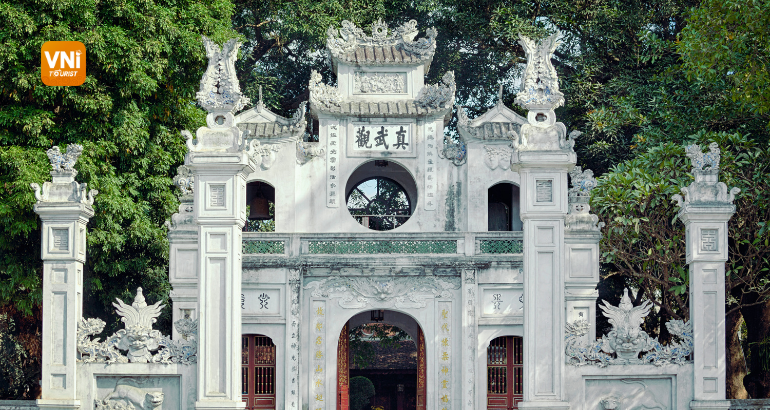Quan Thanh Temple: Guardian of Hanoi’s North
Quan Thanh Temple, located near West Lake in Hanoi, is not just a prominent religious site but also a vital part of the city’s cultural and historical landscape. This temple, dedicated to Huyen Thien Tran Vu, the guardian deity of the north, is one of the Four Sacred Temples of Thang Long and continues to attract both worshippers and tourists with its historical and architectural allure.
Historical Origins
Founding and Dedication
Quan Thanh Temple was founded during the reign of Emperor Ly Thai To (1010-1028), making it one of the oldest temples in Hanoi. The temple is dedicated to Huyen Thien Tran Vu, the revered guardian deity of the north, who is associated with protection and martial prowess. The temple has undergone several renovations throughout its long history but has retained its spiritual essence and historical significance.
Historical Events
Over the centuries, Quan Thanh Temple has witnessed numerous historical events, serving as a focal point for religious and cultural activities. The temple played a significant role in the spiritual life of the residents of Thang Long, the ancient name for Hanoi, providing a place for worship and community gatherings.
Architectural Marvels
Temple Architecture
Quan Thanh Temple is a fine example of traditional Vietnamese architecture, characterized by its harmonious layout and intricate details. The temple complex includes several structures, each with unique architectural features that reflect the artistic and cultural heritage of the time.
Significant Structures
One of the most notable structures within the temple is the main hall, where the imposing bronze statue of Huyen Thien Tran Vu stands. This statue, cast in 1677, is one of the largest bronze statues in Vietnam, symbolizing the strength and power of the deity. The temple also features intricately carved wooden doors, stone steles, and beautifully landscaped gardens, all contributing to its serene and majestic atmosphere.
Notable Features
The bronze statue of Huyen Thien Tran Vu is particularly significant, not only for its size but also for its artistic craftsmanship. The statue depicts the deity with a stern expression, holding a sword and surrounded by mystical symbols. The temple’s carvings and decorations, featuring dragons, phoenixes, and other mythical creatures, add to its spiritual ambiance and artistic value.
Spiritual Importance
Role in Religious Practices
Quan Thanh Temple plays a crucial role in the religious practices and beliefs of Hanoi’s residents. Devotees visit the temple to pray for protection, good fortune, and success, particularly in martial endeavors. The temple is a hub of spiritual activity, with rituals and ceremonies conducted regularly.
Major Festivals and Rituals
The temple is the site of several major festivals and rituals throughout the year. One of the most significant events is the Tran Vu Festival, held annually to honor the deity. During this festival, traditional music, dance performances, and offerings create a vibrant and spiritual atmosphere, attracting large numbers of worshippers and tourists.
Impact on Spiritual Life
Quan Thanh Temple’s spiritual significance extends beyond religious practices. It serves as a place for reflection, meditation, and community bonding. The temple’s tranquil environment and spiritual ambiance provide solace and inspiration to visitors, making it an integral part of Hanoi’s cultural and spiritual landscape.
Visiting Quan Thanh Temple
Best Times to Visit
The best times to visit Quan Thanh Temple are during the early mornings and late afternoons when the temple is less crowded, and the weather is pleasant. Visiting during major festivals offers a unique and immersive cultural experience, though it can be crowded.
Directions and Transportation
Quan Thanh Temple is easily accessible from Hanoi’s city center. Visitors can take a taxi, motorbike, or bus to reach the temple. Located near West Lake, the journey to the temple offers scenic views and a glimpse into the daily life of Hanoi’s residents.
Visitor Tips and Etiquette
Visitors to Quan Thanh Temple should dress modestly, covering their shoulders and knees, to show respect for the sacred site. It’s important to maintain a quiet and respectful demeanor within the temple grounds. Photography is generally allowed, but it’s advisable to check for any specific restrictions, especially during religious ceremonies.
Geographical Location and Nearby Attractions
Location
Quan Thanh Temple is situated near the southern shore of West Lake, one of Hanoi’s most picturesque and tranquil areas. This location not only enhances the temple’s serene atmosphere but also makes it easily accessible from various parts of the city.
Nearby Attractions
- Tran Quoc Pagoda: Located a short distance from Quan Thanh Temple, this is one of the oldest pagodas in Vietnam, offering stunning views of West Lake and rich historical insights.
- Ho Chi Minh Mausoleum: A significant landmark, the mausoleum is a place of pilgrimage for many Vietnamese, paying homage to the country’s founding leader.
- West Lake: Known for its scenic beauty, West Lake is ideal for leisurely walks, cycling, and local cuisine at the many lakeside cafes and restaurants.
- Truc Bach Lake: Adjacent to West Lake, this smaller lake is known for its peaceful ambiance and historical sites, including the Tran Quoc Pagoda and several traditional Vietnamese villages.
Conclusion
Quan Thanh Temple stands as a testament to Hanoi’s rich spiritual heritage and architectural brilliance. Its historical significance, architectural marvels, and spiritual importance make it a must-visit destination for anyone interested in exploring the cultural depths of Hanoi. Whether you are a devotee seeking spiritual solace or a traveler eager to learn about local traditions, Quan Thanh Temple offers a profound and enriching experience. The temple’s prime location near West Lake further enhances its appeal, providing visitors with the opportunity to explore other notable attractions in the area.

